
SpaceX has shared a stunning shot (above) of its next-generation Super Heavy booster on the launchpad.
The image shows the most powerful rocket in the world under a starlit sky at SpaceX’s Starbase site in Boca Chica, Texas. At the bottom of the booster, we can see some of the Super Heavy’s 33 Raptor engines that will blast the rocket to orbit.
The complete launch system comprises the Super Heavy booster and the Starship spacecraft, which sits atop the rocket. When the 395-feet-tall (120 meters) Super Heavy blasts off, its engines create a record 17 million pounds of thrust, nearly double that of NASA’s Space Launch System (SLS), which created 8.8 million pounds of thrust when it lifted off for the first time eight months ago in the Artemis I mission that sent an uncrewed Orion spacecraft around the moon.
Booster 9, as this particular Super Heavy is called, will soon undergo ground-based testing ahead of launch. It follows a failed mission in April when the uncrewed rocket suffered catastrophic issues minutes after launch on what was supposed to be its first-ever orbital flight. With the rocket losing control, mission operators were forced to send a self-destruct command that blew up the Super Heavy in the sky.
While the outcome was far from desired, SpaceX said it was happy that the rocket cleared the launchpad, with its short period of flight providing plenty of data to help it refine the design ahead of its upcoming second flight.
Once fully tested, SpaceX wants to use the vehicle for crew and cargo missions to the moon and even Mars. The American spaceflight company already has a contract with NASA to use a modified version of the Starship spacecraft to put the first woman and first person of color on the lunar surface as part of the highly anticipated Artemis III mission, currently scheduled for 2025.
The Super Heavy’s second test flight could come in the next month or two, so long as regulators don’t put up any hurdles.
The Federal Aviation Administration (FAA) is under pressure as environmental groups have expressed concern about the effect of the Boca Chica launches on the local area. Some have banded together to take legal action against the FAA, claiming the agency failed to properly understand the potential environmental damage that launches there can cause.


